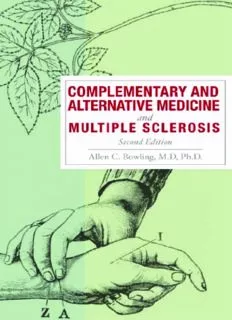Table Of ContentComplementary and Alternative
Medicine and Multiple Sclerosis
Second Edition
This page intentionally left blank
Complementary and Alternative
Medicine and Multiple Sclerosis
Second Edition
Allen C. Bowling, M.D., Ph.D.
Medical Director
The Rocky Mountain Multiple Sclerosis Center
Englewood, Colorado
and
Clinical Associate Professor of Neurology
University of Colorado at Denver and Health Sciences Center
Denver, Colorado
Demos Medical Publishing, LLC, 386 Park Avenue South, New York, New York 10016
Visit our website at www.demosmedpub.com
© 2007 by Demos Medical Publishing, LLC. All rights reserved. This book is protected
by copyright. No part of it may be reproduced, stored in a retrieval system, or transmit-
ted in any form or by any means, electronic, mechanical, photocopying, recording, or oth-
erwise, without the prior written permission of the publisher.
The first edition of this book was published in 2001 under the title
Alternative Medicine and Multiple Sclerosis.
Library of Congress Cataloging-in-Publication Data
Bowling, Allen C.
Complementary and alternative medicine and multiple sclerosis
Allen C. Bowling—2nd ed.
p. ; cm.
Rev. ed. of: Alternative medicine and multiple sclerosis. c2001.
Includes bibliographical references and index.
ISBN-13: 978-1-932603-54-5 (pbk. : alk. paper)
ISBN-10: 1-932603-54-9 (pbk. : alk. paper)
1. Multiple sclerosis—Alternative treatment. I. Bowling, Allen C.
Alternative medicine and multiple sclerosis. II. Title.
[DNLM: 1. Multiple Sclerosis—therapy. 2. Complementary
Therapies. WL 360 B787a 2007]
RC377.B6 2007
616.8'3406—dc22
2006026764
Special discounts on bulk quantities of Demos Medical Publishing books are available
to corporations, professional associations, pharmaceutical companies, health care
organizations, and other qualifying groups. For details, please contact:
Special Sales Department
Demos Medical Publishing
386 Park Avenue South, Suite 301
New York, NY 10016
Phone: 800-532-8663, 212-683-0072
Fax: 212-683-0118
Email: [email protected]
Manufactured in the United States of America
06 07 08 09 10 5 4 3 2 1
To my wife, Diana
This page intentionally left blank
Contents
Foreword by Alan J. Thompson ix
Preface xi
Organization of Chapters and Reading Sequence xiii
Acknowledgments xv
Part 1
Complementary and Alternative Medicine
Chapter 1: Complementary and Alternative Medicine (CAM) 3
Chapter 2: Placebos and Psychoneuroimmunology 16
Chapter 3: Important Precautions About Complementary
and Alternative Medicine and MS 22
Part 2
Types of Therapy
Chapter 4: Acupuncture and Traditional Chinese Medicine 29
Chapter 5: Allergies 40
Chapter 6: Aromatherapy 43
Chapter 7: Aspartame 47
Chapter 8: Ayurveda 50
Chapter 9: Bee Venom Therapy and Other Forms of Apitherapy 55
Chapter 10: Biofeedback 62
Chapter 11: Candida Treatment 66
Chapter 12: Chelation Therapy 68
Chapter 13: Chiropractic Medicine 70
Chapter 14: Colon Therapy, Detoxification, and Enemas 74
Chapter 15: Cooling Therapy 76
Chapter 16: Craniosacral Therapy 80
Chapter 17: Dental Amalgam Removal 83
Chapter 18: Diets and Fatty-Acid Supplements 87
Chapter 19: Enzyme Therapy 106
Chapter 20: Exercise 110
vii
viii Contents
Chapter 21: Feldenkrais 115
Chapter 22: Guided Imagery 117
Chapter 23: Herbs 120
Chapter 24: Hippotherapy and Therapeutic Horseback Riding 146
Chapter 25: Homeopathy 150
Chapter 26: Hyperbaric Oxygen 156
Chapter 27: Hypnosis 159
Chapter 28: Low-Dose Naltrexone (LDN) 163
Chapter 29: Magnets and Electromagnetic Therapy 165
Chapter 30: Marijuana 170
Chapter 31: Massage 174
Chapter 32: Meditation 178
Chapter 33: Music Therapy 182
Chapter 34: Pets 185
Chapter 35: Pilates Method and the Physicalmind Method 188
Chapter 36: Prayer and Spirituality 190
Chapter 37: Prokarin 195
Chapter 38: Reflexology 198
Chapter 39: T’ai Chi 201
Chapter 40: Therapeutic Touch 204
Chapter 41: Toxins 207
Chapter 42: Tragerwork 209
Chapter 43: Vitamins, Minerals, and Other
Nonherbal Supplements 212
Chapter 44: Yoga 240
Part 3
A Five-Step Approach: Integrating Conventional
and Unconventional Medicine
Appendix: Summary of the Effects of Popular
Dietary Supplements 263
References 267
Index 277
Foreword
Few areas in medicine raise as much controversy and debate as the use
of the wide range of interventions contained under the banner heading of
complementary and alternative medicine (CAM). However, it is important
from the outset to appreciate that many approaches are grouped under this
heading and that they often differ fundamentally from one another. One
thing all these approaches do have in common is that they raise great inter-
est and enthusiasm among people with medical conditions, and they are
used by many who believe they derive benefit from them.
Taking a more critical view, major differences exist in the quality and
quantity of evidence supporting the use of approaches contained within
CAM. Furthermore, although such evidence is considered essential by most
medical practitioners and those who seek to guide them, it can be less of an
issue to those with chronic disabling conditions with no cure and inade-
quate symptom management. This is precisely the case with multiple scle-
rosis (MS), a variable condition that may result in progressive disability and
cause a plethora of interacting and distressing symptoms. Many of those
with MS are prepared to consider any possible remedy, and they certainly
want accurate and up-to-date information about all possible therapeutic
approaches.
It is, therefore, not surprising that many people with MS have tried at
least one (and often many more than one) of the approaches constituting
CAM. They require accurate and accessible information, provided in an
objective and clear style, to inform and guide their decision to take (or not
to take) these treatments. This is precisely what Dr. Allen Bowling has
achieved in this comprehensive book on CAM. In his clear and authorita-
tive style, he presents what is currently known on a wide range of potential
treatments. He cites evidence where it exists, and discusses treatment
options clearly and objectively. His approach is firmly based on his clinical
experience and extensive interactions with people with MS. As a result, the
book has a clear patient focus. It is an essential resource for people with
ix
Description:The first edition of this authoritative book quickly became the single source for accurate and unbiased information on complementary and alternative medicine approaches for the management of MS symptoms. The second edition, completely updated throughout, reflects advances in the field since the book

